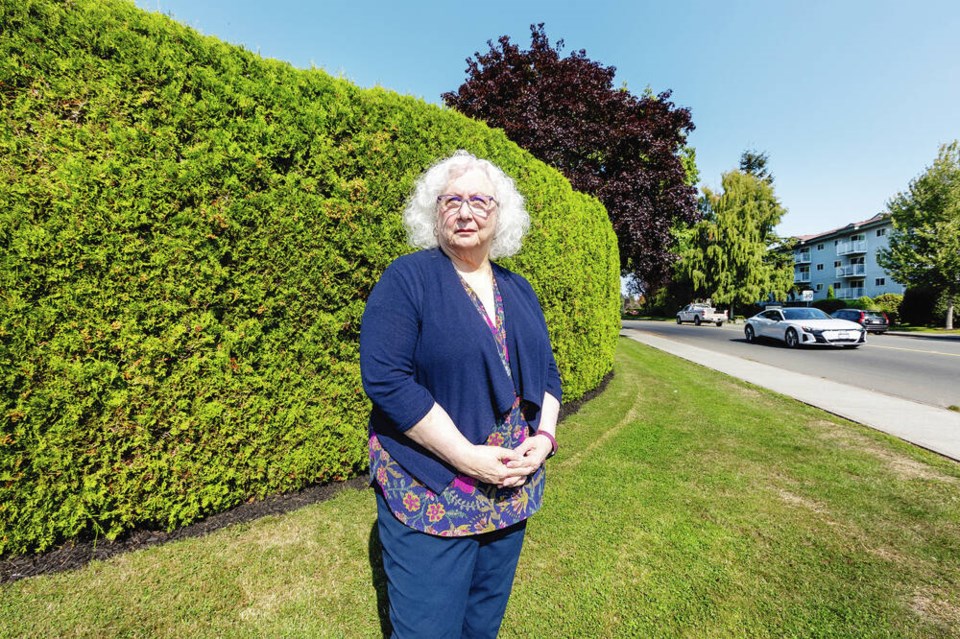Sandra Earle was crossing the street to the Shoal Centre in Sidney, where she was about to lead a ukulele session, when she suddenly became overwhelmingly dizzy and short of breath.
Worried she might lose consciousness at any moment, the 76-year-old called 911 for an ambulance.
It was Monday, Aug. 19 just before 1 p.m. and Earle said she was terrified that her symptoms were serious — even life or death.
The “very nice” dispatcher kept her on the line for nine minutes before she had to go, Earle said. She told Earle an ambulance would be on the way but didn’t offer an estimated time of arrival.
Earle said she lay on the ground so as not to fall, which attracted a crowd of bystanders offering assistance, including some who were walking to the ukulele jam session. Earle also called in a friend from her condominium.
About half an hour later, at 1:28 p.m., with no ambulance in sight, Earle called again. This time, she was told no ambulances were available, and she hung up in frustration. “He was like sorry, there’s no ambulances available and I can’t guarantee when one will come and just left me in the call.”
As a light rain began to fall, Earle said she felt “absolutely devastated” that no assistance was coming “and I knew something was terribly wrong with me.” The dispatcher called back a minute later to suggest she arrange transportation to the nearest hospital, Saanich Peninsula Hospital.
She got into the back of her car with the intention of having her friend drive her to the hospital, but said she was near passing out “and it terrified me.”
“What if I died and she was driving me?” said Earle. “It would have been traumatic for everyone.”
It was at that moment that bystanders saw an ambulance and flagged it down. “It wasn’t even for me — it was for someone else.”
The bystanders asked the paramedics to assess Earle’s condition “and they realized the severity of the situation and took me to Saanich Peninsula.”
A subsequent CT scan showed what’s called a large saddle pulmonary embolism, a rare type of sudden or acute pulmonary embolism that occurs when a large blood clot becomes lodged at the point where the main pulmonary artery divides and branches off into the left and right lungs. That kind of blockage prevents blood flow to both lungs, according to the online publication Medical News Today.
Earle was transferred to Royal Jubilee Hospital, where an ultrasound was done on her leg. It turned out the pulmonary embolism was caused by blood clots deep in the veins of her leg — called deep vein thrombosis.
She had “no idea” this deep vein thrombosis was forming — any possible symptoms she had dismissed as resulting from age or inactivity.
“Once I was in the hands of the ambulance and both hospitals, my care was exemplary,” said Earle.
“It was wonderful.”
Earle is now back home in Sidney, receiving ongoing treatment and taking anti-coagulants.
She said she has only ever called an ambulance once, last fall, for an unrelated matter, and it arrived in a timely manner. But after last month’s experience, she’s worried about what will happen if she or any of her loved ones need immediate care.
“What if it was someone older than me and not as lucid — would they just lie there in the grass and who knows?”
She’s also wondering why police or firefighters couldn’t have attended to assess the situation if the ambulance service in the area was busy with a higher-priority case. At no time did the dispatcher ask to speak to the bystanders to get greater clarity on the severity of the situation, she said.
Bowen Osoko, spokesperson for B.C. Emergency Health Services, said in a statement on Friday the ambulance service continues to look into the specifics of the case, but he noted the service prioritizes ambulance calls based on information received from the caller.
“Based on information provided by the patient, the call was coded yellow, or non-urgent (not serious or life-threatening),” he said. “The call’s colour coding did not change following subsequent communication with the patient.”
The highest-priority purple is for life-threatening cases such as cardiac arrest, red is also for life-threatening or critical symptoms such as chest pain, orange is for urgent and potentially serious but not immediately life-threatening cases, while yellow is for non-urgent cases such as a sprained ankle.
Osoko said Earle’s call was coded yellow in part because she was speaking coherently and breathing and conscious. Fire-department paramedics typically act on an incident coded orange and above, he said.
There is a process to upgrade a call to a higher-priority response “if a patient’s condition worsens,” he said.
Earle said she has contacted Island Health’s Patient Care Quality Office, which will review her case.
>>> To comment on this article, write a letter to the editor: [email protected]



